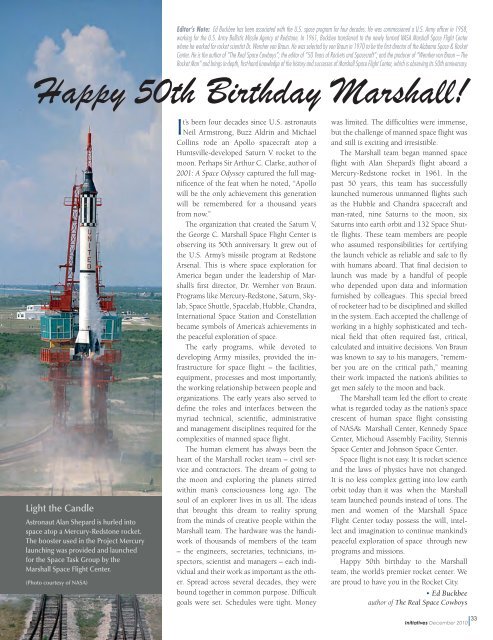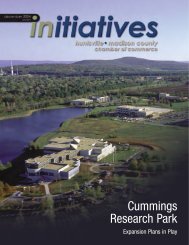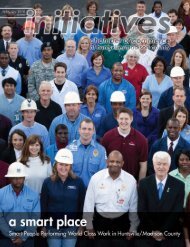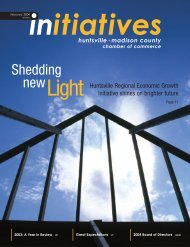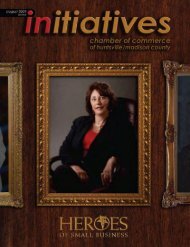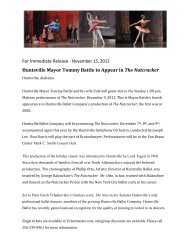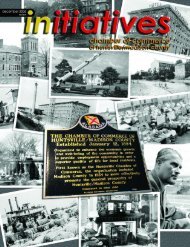The Huntsville Regional Economic Growth Initiative (HREGI ...
The Huntsville Regional Economic Growth Initiative (HREGI ...
The Huntsville Regional Economic Growth Initiative (HREGI ...
You also want an ePaper? Increase the reach of your titles
YUMPU automatically turns print PDFs into web optimized ePapers that Google loves.
Editor’s Note: Ed Buckbee has been associated with the U.S. space program for four decades. He was commissioned a U.S. Army officer in 1958,<br />
working for the U.S. Army Ballistic Missile Agency at Redstone. In 1961, Buckbee transferred to the newly formed NASA Marshall Space Flight Center<br />
where he worked for rocket scientist Dr. Wernher von Braun. He was selected by von Braun in 1970 to be the first director of the Alabama Space & Rocket<br />
Center. He is the author of “<strong>The</strong> Real Space Cowboys”; the editor of “50 Years of Rockets and Spacecraft”; and the producer of “Wernher von Braun – <strong>The</strong><br />
Rocket Man” and brings in-depth, first-hand knowledge of the history and successes of Marshall Space Flight Center, which is observing its 50th anniversary.<br />
Happy 50th Birthday Marshall!<br />
Light the Candle<br />
Astronaut Alan Shepard is hurled into<br />
space atop a Mercury-Redstone rocket.<br />
<strong>The</strong> booster used in the Project Mercury<br />
launching was provided and launched<br />
for the Space Task Group by the<br />
Marshall Space Flight Center.<br />
(Photo courtesy of NASA)<br />
It’s been four decades since U.S. astronauts<br />
Neil Armstrong, Buzz Aldrin and Michael<br />
Collins rode an Apollo spacecraft atop a<br />
<strong>Huntsville</strong>-developed Saturn V rocket to the<br />
moon. Perhaps Sir Arthur C. Clarke, author of<br />
2001: A Space Odyssey captured the full magnificence<br />
of the feat when he noted, “Apollo<br />
will be the only achievement this generation<br />
will be remembered for a thousand years<br />
from now.”<br />
<strong>The</strong> organization that created the Saturn V,<br />
the George C. Marshall Space Flight Center is<br />
observing its 50th anniversary. It grew out of<br />
the U.S. Army’s missile program at Redstone<br />
Arsenal. This is where space exploration for<br />
America began under the leadership of Marshall’s<br />
first director, Dr. Wernher von Braun.<br />
Programs like Mercury-Redstone, Saturn, Skylab,<br />
Space Shuttle, Spacelab, Hubble, Chandra,<br />
International Space Station and Constellation<br />
became symbols of America’s achievements in<br />
the peaceful exploration of space.<br />
<strong>The</strong> early programs, while devoted to<br />
developing Army missiles, provided the infrastructure<br />
for space flight – the facilities,<br />
equipment, processes and most importantly,<br />
the working relationship between people and<br />
organizations. <strong>The</strong> early years also served to<br />
define the roles and interfaces between the<br />
myriad technical, scientific, administrative<br />
and management disciplines required for the<br />
complexities of manned space flight.<br />
<strong>The</strong> human element has always been the<br />
heart of the Marshall rocket team – civil service<br />
and contractors. <strong>The</strong> dream of going to<br />
the moon and exploring the planets stirred<br />
within man’s consciousness long ago. <strong>The</strong><br />
soul of an explorer lives in us all. <strong>The</strong> ideas<br />
that brought this dream to reality sprung<br />
from the minds of creative people within the<br />
Marshall team. <strong>The</strong> hardware was the handiwork<br />
of thousands of members of the team<br />
– the engineers, secretaries, technicians, inspectors,<br />
scientist and managers – each individual<br />
and their work as important as the other.<br />
Spread across several decades, they were<br />
bound together in common purpose. Difficult<br />
goals were set. Schedules were tight. Money<br />
was limited. <strong>The</strong> difficulties were immense,<br />
but the challenge of manned space flight was<br />
and still is exciting and irresistible.<br />
<strong>The</strong> Marshall team began manned space<br />
flight with Alan Shepard’s flight aboard a<br />
Mercury-Redstone rocket in 1961. In the<br />
past 50 years, this team has successfully<br />
launched numerous unmanned flights such<br />
as the Hubble and Chandra spacecraft and<br />
man-rated, nine Saturns to the moon, six<br />
Saturns into earth orbit and 132 Space Shuttle<br />
flights. <strong>The</strong>se team members are people<br />
who assumed responsibilities for certifying<br />
the launch vehicle as reliable and safe to fly<br />
with humans aboard. That final decision to<br />
launch was made by a handful of people<br />
who depended upon data and information<br />
furnished by colleagues. This special breed<br />
of rocketeer had to be disciplined and skilled<br />
in the system. Each accepted the challenge of<br />
working in a highly sophisticated and technical<br />
field that often required fast, critical,<br />
calculated and intuitive decisions. Von Braun<br />
was known to say to his managers, “remember<br />
you are on the critical path,” meaning<br />
their work impacted the nation’s abilities to<br />
get men safely to the moon and back.<br />
<strong>The</strong> Marshall team led the effort to create<br />
what is regarded today as the nation’s space<br />
crescent of human space flight consisting<br />
of NASA’s Marshall Center, Kennedy Space<br />
Center, Michoud Assembly Facility, Stennis<br />
Space Center and Johnson Space Center.<br />
Space flight is not easy. It is rocket science<br />
and the laws of physics have not changed.<br />
It is no less complex getting into low earth<br />
orbit today than it was when the Marshall<br />
team launched pounds instead of tons. <strong>The</strong><br />
men and women of the Marshall Space<br />
Flight Center today possess the will, intellect<br />
and imagination to continue mankind’s<br />
peaceful exploration of space through new<br />
programs and missions.<br />
Happy 50th birthday to the Marshall<br />
team, the world’s premier rocket center. We<br />
are proud to have you in the Rocket City.<br />
• Ed Buckbee<br />
author of <strong>The</strong> Real Space Cowboys<br />
33<br />
<strong>Initiative</strong>s December 2010


